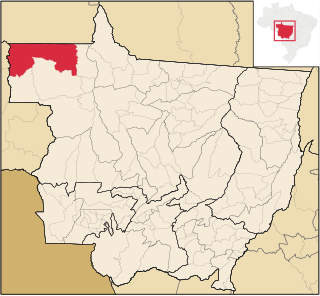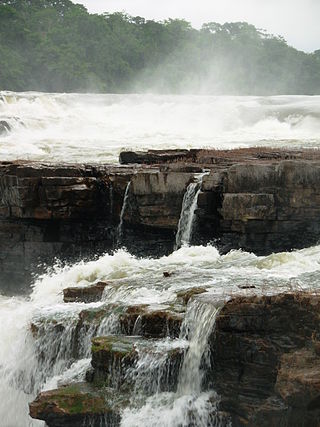History
The Sucunduri State Park was created by Amazonas state governor decree 24.810 of 21 January 2005 with the objectives of preserving natural ecosystems of great relevance and scenic beauty, allowing scientific research, education, environmental interpretation, recreation in contact with nature and ecotourism. The state park excluded private property whose owners could prove legal title. It is administered by Ipaam: Instituto de Proteção Ambiental do Amazonas.
In 2014 the federal government was considering a proposal to declare the Juruena National Park an area of public utility in preparation for constructing two hydroelectric dams in the site, the São Simão Alto and Salto Augusto Baixo. The planned dams had a forecast capacity of 4,940 MW. The National Council for Energy Policy (CNPE) had two seats for civil society members, but these had not been filled. WWF-Brasil led a campaign against the energy project, which would flood an area of over 40,000 hectares (99,000 acres). In September 2014 the federal government withdrew its proposal. The dams would have flooded parts of the Juruena National Park, Igarapés do Juruena State Park and the Escondido and Apiaká do Pontal indigenous territories in Mato Grosso, and would have affected part of the Sucunduri State Park in Amazonas and other indigenous territories.
On 17 March 2015 an agreement was made to compensate for the irreversible negative environmental impacts of the Teles Pires hydroelectric project through payment of R$500,000 for use by the park.
Environment
The state park contains the oldest geological domains of the Apuí mosaic, consisting of rocks from the Proterozoic and Paleozoic. These rocks form the Sucunduri Dome between the Aripuanã and Juruena rivers, and cause the many rapids and waterfalls on those rivers. The Bararati River, a left tributary of the Juruena, flows through the park from south to north. The Sucunduri River rises in the park and flows north. It later joins the Acari River to form the Canumã River. The Monte Cristo rapids and the Sucunduri River Falls (Saltos do Rio Sucunduri) are well-known attractions. The Monte Cristo rapids on the Sucunduri is an area with great numbers and diversity of animals and birds. In 2006 it was also the location of an illegal mining settlement. The Augusto Salto on the Juruena has high tourist potential.
The park is in a contact zone between the Amazon rainforest and Cerrado biomes and has a wide diversity of flora including terra firma forest, flooded forest, campos rupestres, campina and campinarana. Vegetation is 52% open rainforest, 32% dense rainforest, 4% savanna-rainforest contact and 12% savannah-seasonal forest contact. Tree species include mahogany, cedar, copaiba, andiroba, Brazil nut and rosewood. Rosewood is the most threatened due to its high economic value. The region has more than 13 endemic species of primates. Surveys of the west of the mosaic have identified 850 tree species, 46 mammals, more than 300 birds, 27 reptiles, 30 amphibians and almost 100 species of fish. Several previously unknown aquatic species have been found.
Conservation
The park is an integral part of the Apuí Mosaic, which totals 2,467,243 hectares (6,096,690 acres) in area and contains the Guariba and Sucunduri State Parks; Bararati and Aripuana sustainable development reserves; Guariba Extractive Reserve; and Sucunduri, Aripuana, Apuí and Manicoré state forests. It is part of the 90,000 square kilometres (35,000 sq mi) Southern Amazon Conservation Corridor, a region under strong deforestation pressure due to the advance of the agricultural frontier into the Brazilian Amazon region. The conservation unit is supported by the Amazon Region Protected Areas Program.

The Juruena River is a 1,240 km (770 mi) long river in west-central Brazil, in the state of Mato Grosso.

Apuí is a municipality located in the Brazilian state of Amazonas. Its population was 22,359 (2020) and its area is 54,240 km2.

Novo Aripuanã is a municipality located in the Brazilian state of Amazonas.

Colniza is a municipality in the state of Mato Grosso, Brazil.

Aripuanã River is a river in the Mato Grosso and Amazonas states in north-western Brazil. It is a tributary of the Madeira River in the Amazon Basin. The town of Novo Aripuanã is located on its banks where it merges into the Madeira River. The town of Aripuanã is also on its banks, but on the upper (southern) section of the river.
Sucunduri River is a river of Amazonas state in north-western Brazil, one of the main headwaters of the Canumã River.

Juruena National Park, declared in 2006, is the third largest national park of Brazil. It is located along the Juruena River, in the north of Mato Grosso state and the south of Amazonas state. It forms part of a corridor of protected areas that is meant to contain agricultural expansion into the Amazon rainforest.

The Campos Amazônicos National Park is a National park in the states of Rondônia, Amazonas and Mato Grosso, Brazil.
The Igarapés do Juruena State Park is a state park in the state of Mato Grosso, Brazil.
The Sucunduri State Forest is a state forest in the state of Amazonas, Brazil.
The Manicoré State Forest is a state forest in the state of Amazonas, Brazil.
The Aripuanã Sustainable Development Reserve is a sustainable development reserve in the state of Amazonas, Brazil.
The Aripuanã State Forest is a State forest in the state of Amazonas, Brazil.
The Apuí Mosaic is a protected area mosaic in the state of Amazonas, Brazil.
The Southern Amazon Mosaic is a protected area mosaic in Brazil.
The Guariba State Park is a State park in the state of Amazonas, Brazil.
The Guariba Extractive Reserve is an extractive reserve in the state of Amazonas, Brazil.
The Bararati Sustainable Development Reserve' is a sustainable development reserve in the state of Amazonas, Brazil.
The Apuí State Forest is a state forest in the state of Amazonas, Brazil.

The Cristalino State Park is a state park in the state of Mato Grosso, Brazil.
This page is based on this
Wikipedia article Text is available under the
CC BY-SA 4.0 license; additional terms may apply.
Images, videos and audio are available under their respective licenses.







